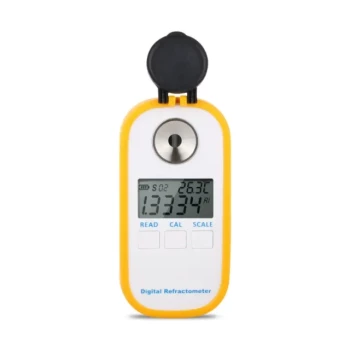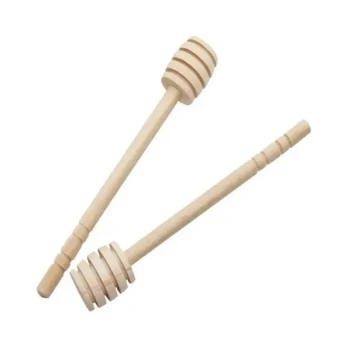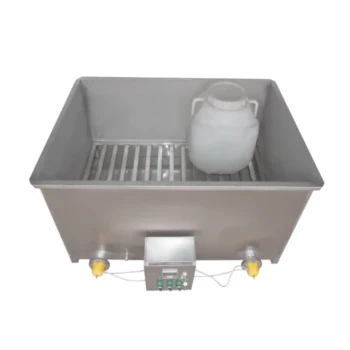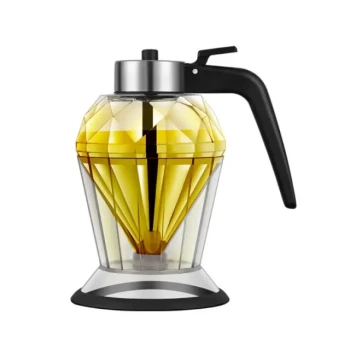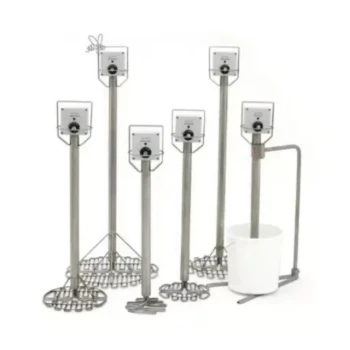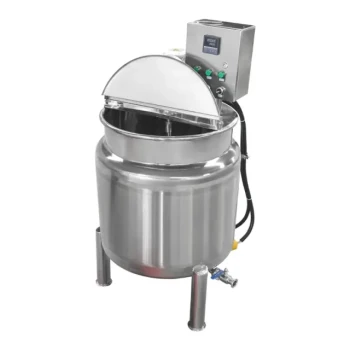To best store your honey refractometer, you must place it in a cool, dry, and dark location, ideally inside the protective case it came with. Proper storage is the final step in a necessary maintenance routine that begins with immediate and thorough cleaning after each use. This prevents environmental damage, protects the delicate optics, and ensures the instrument remains accurate over its lifetime.
The core principle is simple: a refractometer's value is in its accuracy. Proper storage is not just about putting a tool away; it is a critical practice that directly preserves the optical integrity and calibration of the instrument, safeguarding your ability to get trustworthy measurements.
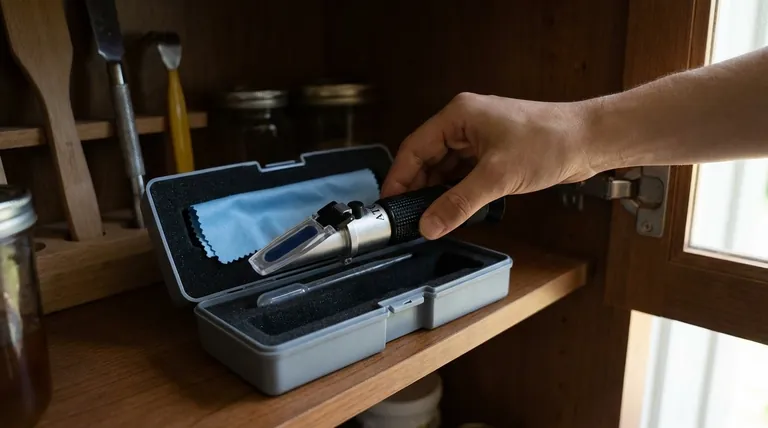
Why Proper Storage is Critical for Accuracy
A refractometer is a precision optical instrument. Its storage conditions are as important as its handling during use. The goal of storage is to create a stable, non-damaging environment.
Protecting the Prism and Daylight Plate
The heart of the refractometer is its glass prism and the daylight plate that covers it. Honey residue, dust, or moisture left on these surfaces can cause permanent damage.
Dried honey, in particular, becomes abrasive and can scratch the delicate optical surface when you try to clean it later. Scratches or haze on the prism will interfere with light transmission, leading to blurry or incorrect readings.
Preventing Environmental Damage
The two biggest environmental threats to a refractometer are moisture and heat.
Excessive moisture or humidity can seep into the instrument's body, fostering mold growth on internal optical components. This will permanently ruin the tool.
High heat or direct sunlight can cause the instrument's body to warp or adhesives to fail. Extreme temperature fluctuations can also affect the instrument's internal components, potentially causing it to lose calibration.
The Correct Storage Protocol
Following a consistent routine after every use is the key to preserving your refractometer. Think of it as a mandatory three-step process, not an optional afterthought.
Step 1: Meticulous Cleaning (The Prerequisite)
The storage process begins the moment you finish taking a reading. You must clean the instrument immediately.
Use a soft, damp, lint-free cloth to gently wipe all honey residue from the prism and daylight plate. Never submerge the refractometer in water, as this will destroy it.
Step 2: Ensure it is Completely Dry
After wiping it with a damp cloth, use a separate dry, lint-free cloth to remove any remaining moisture. Storing a wet refractometer is a direct invitation for mold and corrosion.
Step 3: Use the Protective Case in a Stable Location
The hard case your refractometer came in is its best defense against physical shock and dust.
Once clean and dry, place the instrument securely in its case. Store the case in a cool, dry, and dark place like a cupboard or a drawer, away from direct sunlight, heaters, or damp areas.
Common Pitfalls to Avoid
Mistakes in storage are the most common cause of a refractometer failing prematurely. Avoiding these simple errors is crucial.
Storing Without Cleaning
This is the number one mistake. Hardened honey is difficult to remove without scratching the prism. It can also attract pests or allow mold to develop.
Exposing it to Temperature Extremes
Never leave your refractometer in a vehicle, a sunny windowsill, or an unheated shed. The rapid temperature changes and potential for extreme heat or cold will damage the instrument and compromise its calibration.
Using Harsh Cleaners or Abrasive Cloths
Do not use chemical solvents, alcohol, or paper towels to clean the prism. These can damage the delicate optical coatings or leave behind abrasive wood fibers that cause scratches. Stick to clean water and a microfiber cloth.
Making the Right Choice for Your Goal
Integrate this process into your honey-testing workflow to make it an automatic habit.
- If your primary focus is long-term reliability: Always clean the prism with a damp, lint-free cloth immediately after use and store it in its case.
- If your primary focus is consistent accuracy: Store the refractometer in a temperature-stable location, like an indoor cupboard, to prevent calibration drift caused by heat or moisture.
- If your primary focus is preventing physical damage: Never store the instrument dirty, wet, or outside of its protective case, which is designed to absorb shocks.
Treating your refractometer with care is the simplest way to guarantee trustworthy honey measurements for years to come.
Summary Table:
| Storage Goal | Key Action | Pitfall to Avoid |
|---|---|---|
| Long-Term Reliability | Clean immediately after use with a damp, lint-free cloth. | Storing the instrument without cleaning first. |
| Consistent Accuracy | Store in a cool, dry, dark, and temperature-stable location. | Exposing it to direct sunlight or temperature extremes. |
| Preventing Physical Damage | Always use the provided protective case. | Using harsh chemicals or abrasive cloths for cleaning. |
Ensure your honey quality control is built on reliable data. A well-maintained refractometer is essential for accurate moisture readings. At HONESTBEE, we supply commercial apiaries and beekeeping equipment distributors with the durable, professional-grade tools needed for precise honey analysis. Protect your investment and ensure your measurements are always trustworthy.
Contact our wholesale experts today to discuss your equipment needs and keep your operations running smoothly.
Visual Guide
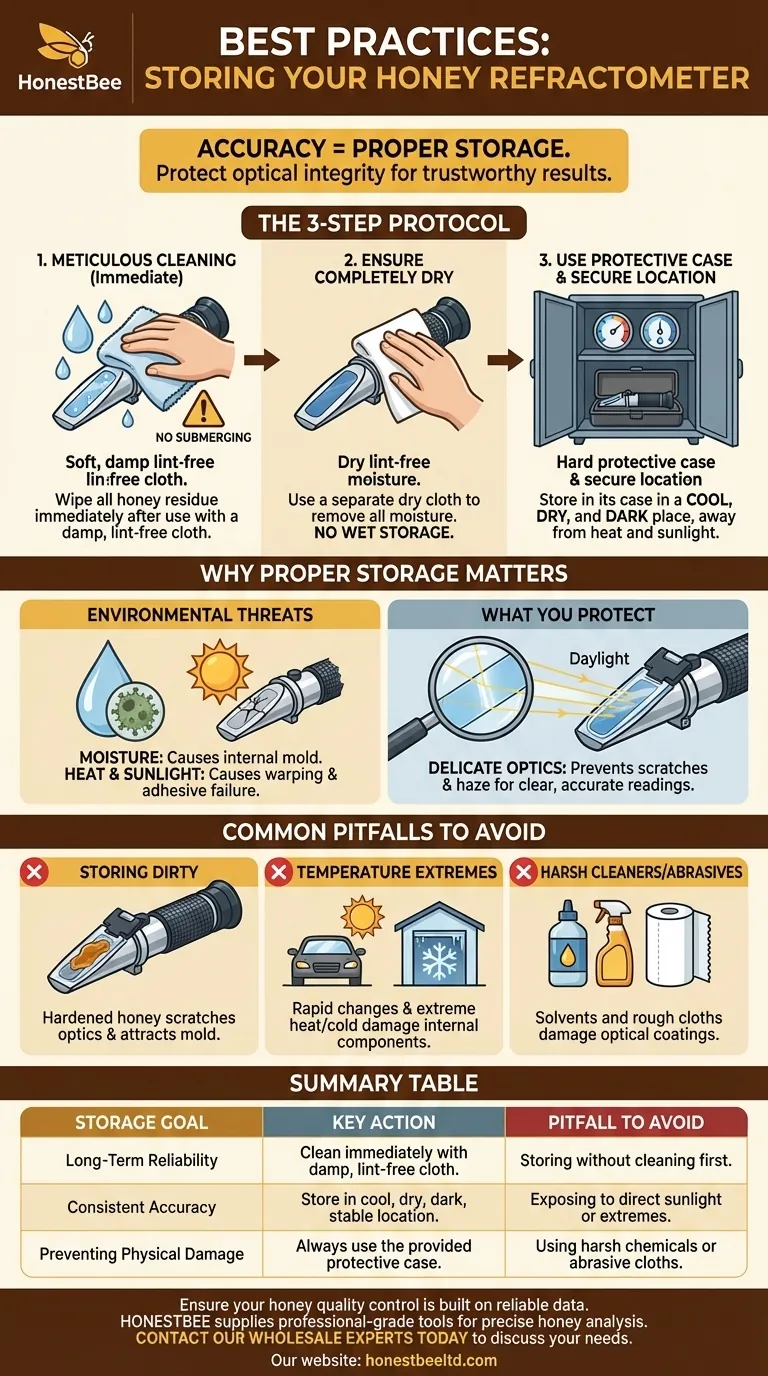
Related Products
- Precision Honey Refractometer Instrument for Quality Assessment
- Digital Honey Refractometer for Precision Measurement of Optimal Honey Quality
- Natural Wood Honey Dipper for Tea Coffee and Desserts
- 8-Frame Electric Self-Reversing Honey Extractor Spinner for Commercial Honey Extraction Equipment
- 24 Frame Honey Extractor Commercial Radial Honey Frame Extraction Machine
People Also Ask
- What are the key points for proper usage of a honey refractometer? Ensure Accurate Moisture Readings Every Time
- Why is a honey refractometer important for beekeepers? Ensure Quality and Prevent Fermentation
- What is a honey refractometer? The Essential Tool for Perfect Honey Quality
- What are the features of the Standard Refractometer for honey moisture content? Essential Tools for Quality Control
- What is a honey refractometer and what is its purpose? Ensure Honey Quality and Prevent Spoilage

